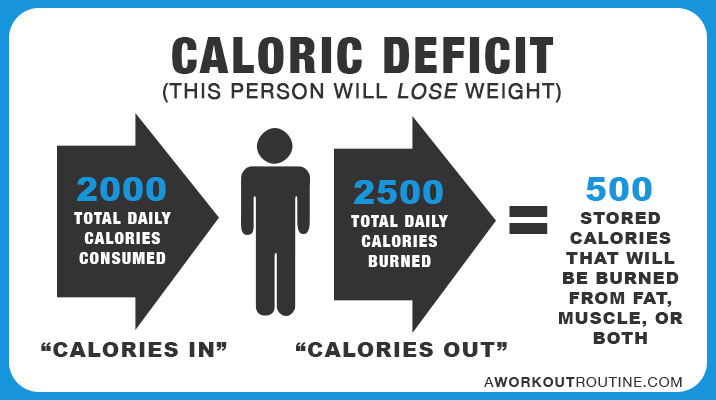When someone asks me what the best fat burning exercises and workouts are, I respond with something they probably didn’t want to hear…
“Fat loss is primarily a function of your diet, not your workout.”
Yeah, that’s not quite the simple list of “best exercises” they were hoping for.
For that reason, what comes next is often a response filled with a combination of confusion and annoyance. Here now is my attempt at clearing all of that up once and for all.
The Truth About Fat Burning Exercises
There aren’t any.
Taaadaaa!

Let me explain.
You see, the idea that there are specific exercises that burn fat, or even that there are certain types of workouts that will – in and of themselves – make you lose weight, is not actually true.
That’s not how fat loss works.
The Sole Cause Of Fat Loss
The one and only thing that will ever “burn fat” is being in a consistent caloric deficit.
A caloric deficit is the state your body is in when you consume fewer calories than you burn (or burn more calories than you consume, just two different ways of saying the same thing). When this happens, your body burns your stored fat as a fuel source instead.
Please take a second to let that sink in, because it’s always the sole underlying cause of fat loss. Yes, even when it may seem like it’s something else. Details here: The Truth About Fat Loss

3 Ways To Create Your Deficit
As for the deficit itself, it can be created three different ways:
- Diet
Let’s pretend you maintain your current weight eating 2500 calories per day (just an example). If you started eating 2000 calories per day (a 500-calorie deficit), you’d lose fat. Yup, even if you weren’t working out at all. (Details here: How To Lose Weight Without Exercise) - Exercise
Sticking with the same example, if you ate 2500 calories per day but then burned an additional 500 calories per day by working out, that same 500-calorie deficit would exist and fat would be lost yet again. - Diet And Exercise
If you ate 250 fewer calories and burned 250 extra calories per day, guess what would happen? The same 500-calorie deficit would exist and fat loss would happen. (By the way, there’s nothing special about a 500-calorie deficit. It’s just the nice round number I’m using for the sake of showing examples.)
All three of these methods work because the same fundamental requirement is always present: a caloric deficit.
If that’s there, you lose fat.
If it’s not, you don’t.
Simple as that.
Now here’s why this matters.
5 Myths About Exercise And Fat Loss
Once you understand that a caloric deficit is the ONLY thing that makes fat loss happen, you’re probably left scratching your head thinking about all of the other things you’ve heard about that supposedly make it happen.
I’m not even talking about the countless fad diets that claim weight loss has nothing to do with calories and instead occurs due to some other “thing” (e.g. carbs, sugar, gluten, fat, non-Paleo foods, etc.). That’s a separate topic that I cover in my guide to how the low carb diet actually works, as well as in my breakdown of the best way to lose weight.
I’m talking strictly about exercise here and the many fat burning myths that surround it.
For example:
- Spot Reduction Is Real
- Lighter Weight/Higher Reps = Weight Loss
- Burning Fat And Building Muscle Require Different Exercises
- “Toning” Is A Real Thing
- Cardio And Metabolic Workouts Burn Fat
Let’s clear up each of these right now…
1. Spot Reduction Is Real
Spot reduction is the idea that there are special exercises that target specific areas of fat on your body.
As in, ab exercises burn belly fat, back exercises burn back fat, leg exercises burn leg fat, chest exercises target man boobs, face exercises get rid of face fat, and so on.
This is not actually true.
Why? Because exercises target muscles, not the fat on top of those muscles.
This is just a silly myth that has been disproven over and over again in the real-world, as well as in studies (sources here, here, and here). For more on this topic, check out: How To Lose Fat From Your Stomach, Arms, Thighs, And More
2. Lighter Weight/Higher Reps = Weight Loss
This is the idea that weight training exercises done with lighter weight in higher rep ranges (e.g. 12+ reps per set) burn fat, while exercises done with heavier weight in lower rep ranges (e.g. 1-8 reps per set) build muscle.
This is also a myth, and for two separate reasons:
- First, while some rep ranges may be more or less ideal for certain goals, muscle can be built in EVERY rep range, regardless of how high it may be (source).
- Second, there’s nothing that happens when you use less weight or more reps that suddenly gives an exercise the magical ability to target the fat on the body part you’re training (see the spot reduction myth we just covered).
In reality, the most significant thing that can happen when you switch from lifting heavier weight (for the purpose of gaining muscle) to lifting lighter weight (for the supposed purpose of burning fat) is a reduction in the stimulus that gives your body a reason to keep the muscle you have… potentially resulting in muscle loss.
It’s the complete opposite of what you want to do when you’re trying to lose weight without losing muscle.
3. Burning Fat And Building Muscle Require Different Exercises
Next we have the fun idea that certain exercises – typically isolation exercises, but also certain machine and/or body weight exercises – are automatically “fat burning exercises,” while others – such as big compound exercises performed with free weights – are automatically “muscle building exercises.”
Yet again, this is a myth.
Your body doesn’t know or care about what exercise it is performing or what type of equipment it is using. It doesn’t think “okay, this feels like a barbell” or “this definitely seems like a weight loss exercise” or “wait… this is a machine” or “ah, this is an isolation exercise!”
All your body knows or cares about is the amount of tension, fatigue, and damage an exercise generates, and varying degrees of each can be produced regardless of the type of exercise being done or equipment being used.
And none of it is capable of directly targeting body fat.
4. “Toning” Is A Real Thing
Here we have the idea that there are certain types of exercises and workouts that are for “toning.”
As in, if you want to get big and bulky, you do these exercises and these workouts, but if you want to get lean and toned and defined, you do these exercises and these workouts instead… because they are for this specific type of body.
Sorry, but no.
You can’t “tone” or “define” a part of your body. All you can do is lose or gain muscle on that body part, or lose or gain fat on that body part. That’s it.
And, just in case I need to say it again, there’s nothing you can do (with the exception of liposuction) to target a particular area of fat on a particular part of your body, nor can you choose exactly where you lose weight from.
That’s not possible.
And “toning workouts”? That’s a bullshit concept marketed to women that perpetuates a variety of counterproductive weight training myths. Full details here: The Toning Workout Routine For Women
5. Cardio And Metabolic Workouts Burn Fat
Finally, we have the most common types of fat burning exercise: cardio and metabolic training.
These two categories of activity encompass everything from traditional low/moderate intensity steady state cardio (e.g. treadmill, bike, elliptical, stairmaster, etc.), to HIIT (high intensity interval training), to stuff like battle ropes, sled drags, sledgehammer work, kettlebell work, etc., to anything that essentially turns weight training into a form of cardio (e.g. circuits, barbell complexes, CrossFit, etc.).
When someone decides to start working out for the purpose of losing weight, this is the type of activity they tend to do the most.
Why? Because the typical person is under the impression that the simple act of doing this form of training means fat is going to be lost.
But that’s not necessarily true, because exercise like this – in and of itself – doesn’t cause fat loss. It burns calories. And only if there ends up being a consistent caloric deficit present – in conjunction with your diet – will any meaningful amount of body fat actually be lost.
Which means you could do fasted steady state cardio 6 days a week, HIIT 3 days a week, CrossFit 4 days a week, traditional weight training 5 days a week, add in metabolic finishers at the end of every workout, walk to work everyday, play some sports on the side, and more… AND YET STILL not burn a single pound of fat if your diet is canceling out whatever calories you’re burning and preventing you from being in the deficit you need to be in for fat to be lost.
It’s About The Deficit, Not The Exercise
These 5 myths are common examples of why so many people fail to lose weight despite “working out all the time.”
They focus mostly (if not entirely) on their workout, thinking they are doing all of the “fat burning” things they need to be doing… and then either ignore their diet, or just assume “it’s good enough,” or maybe that the exercise they’re doing can make up for bad eating habits.
Nope.
That’s unfortunately not gonna cut it, because most of this stuff (like spot reduction and toning) is just ineffective nonsense, and the stuff that can potentially work (like cardio exercise) is laughably easy to out-eat.
Which means, no matter how many calories you’re burning during your workouts, they’re not going to burn any fat if you’re still eating an amount that prevents a deficit from being present.
And so, what it comes down to is this.
Every single type of exercise that burns a meaningful amount of calories has the POTENTIAL to cause fat loss… but only if it leads to a consistent caloric deficit existing in conjunction with your diet.
If that does indeed happen, you’ll be burning fat.
If it doesn’t, you won’t be, and all of the best “fat burning exercises” in the world won’t change that.
What’s Next?
If you liked this article, you’ll also like…
- What Is The Best Weight Loss Diet Plan?
- How Much Cardio Should I Do To Lose Weight?
- The 10 Best Fat Burning Foods
- What’s The Best Weight Training Workout For Fat Loss?
